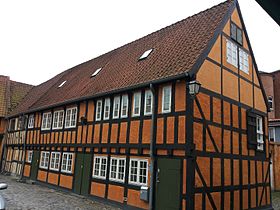
Business- and Agricultural Bank of Jutland is a listed building and a former Danish bank in Aarhus.
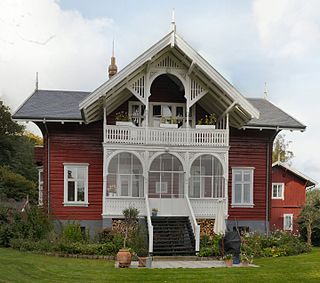
Det Norske Hus is a listed building in Aarhus, Denmark. The house was first built in 1888 and it was listed in the Danish national registry of protected buildings and places by the Danish Heritage Agency on 14 October 1996. The house is situated on the northern border of Riis Skov in the northern neighbourhood Risskov. The building is today privately owned and used as a home.

Trods Katholm is a former manor house and a listed building in Aarhus Municipality, Denmark. The house was built in 1606 and was listed by the Danish Heritage Agency on 2 September 1994. The building complex is situated in the central Indre By neighbourhood on Fredens Torv by the Aarhus River. It is one of the oldest preserved buildings in the city with a history of many different uses. The listing includes the main building of the former manor built in 1606 and an adjacent former warehouse building from 1850.

Mejlen or Asylet Børnely is a house, former asylum and a listed building in Aarhus, Denmark. The house was built in 1768 and was listed in the national Danish registry of protected buildings and places by the Danish Heritage Agency on 8 November 2008. The building originally functioned as a kindergarten but is today home to an art gallery.
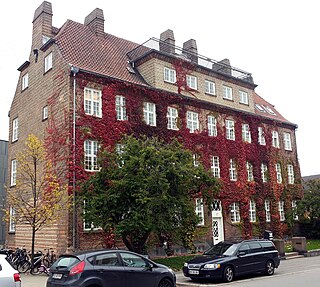
The Baumann House is a listed building in Aarhus, Denmark. The building was constructed in 1911 and was listed in the national Danish registry of protected buildings and places by the Danish Heritage Agency on 18 September 1996. The building is situated in the central Indre By neighborhood on Jægergårdsgade adjacent to the Aarhus Central Workshops.

Juul's House is a house and a listed building in Aarhus, Denmark. The house was built in 1629 and was listed on the national Danish registry of protected buildings and places by the Danish Heritage Agency on 1 April 1984. The building is one of the oldest in the city and it is situated in the historical Latin Quarter on Mejlgade. It has been a paint shop since 1842 and it is the oldest paint shop in the country.
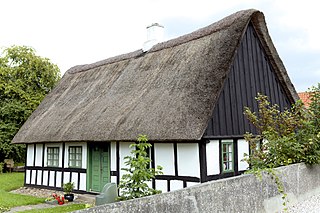
Thorald's House is a house and a listed building in Aarhus, Denmark. The house was built in approximately 1750 and was listed on the Danish registry of protected buildings and places by the Danish Heritage Agency on 21 March 2012. The house is situated in the Tilst suburb 8 km west of the city center, adjacent to the Tilst Church.

Badstuegade 1H is a house and a listed building in Aarhus, Denmark. The house was built in 1809 and was listed on the Danish registry of protected buildings and places by the Danish Heritage Agency on 7 October 1970. The house is situated in the historic and central Latin Quarter neighbourhood on Badstuegade by Pustervig square.

Hald's House is a 4-winged house and a listed building in Aarhus, Denmark. The house was built in 1870 and was listed on the Danish registry of protected buildings and places by the Danish Heritage Agency on 7 October 1970. The house is situated in the central Indre by neighborhood on Vesterport.
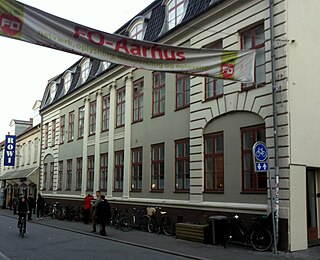
Herskind's House is a house and a listed building in Aarhus, Denmark. The house was built in approximately 1850 and was listed on the Danish registry of protected buildings and places by the Danish Heritage Agency on 2 October 1970. The house is situated in the historic Indre by neighborhood on Frederiksgade, close to the City Hall.

Mønsted's House is a house and a listed building in Aarhus, Denmark. The house was built in 1810 and was listed on the Danish registry of protected buildings and places by the Danish Heritage Agency on 24 March 1950. The building is situated in the historic Indre by neighborhood on Vestergade across from the Church of Our Lady. The reason for the listing was partly the historical significance and importance of the building and the impact of its former inhabitants.

Mejlgade is a street in Aarhus which runs north to south from Østbanetorvet to Skolegade and intersects Nørrebrogade. The street is situated in the historic Latin Quarter neighborhood and has the highest number of historic and listed buildings in the city. Mejlgade is one-way and no-parking zone for cars for most of its length and pedestrians and cyclists are given priority. The single lane is tiled and a part of the Cykelringen bicycle ring which circumnavigates the city center. Mejlgade has a high number of small specialty shops and some cafés and bars.
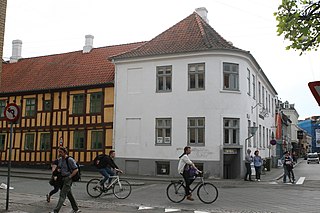
Aarhus Art Academy is an art school in Aarhus, Denmark. The school resides in a listed building on Vestergade 29 in the old medieval inner city, comprised by the neighborhood of Indre By. The building was listed on the Danish registry of protected buildings and places by the Danish Heritage Agency on 3 December 1924. The school offers a 4-year arts programme and a number of courses in sculpting, painting, design, ceramics, photo and webdesign.

Vestergade is a street in Aarhus, Denmark, which runs east to west from the central square of Store Torv to the city park of Åparken at Carl Blochs Gade, intersecting the main streets of Grønnegade and Vester Allé along its course. Vestergade begins in the Indre By neighborhood and ends in neighborhood of Vesterbro, close to CeresByen. Vestergade has some of the best preserved 18th-century merchant estates in Aarhus and a history of creativity and artistic expression.

Studsgade is a street in Aarhus which runs north to south from Nørreport to Klostergade and Graven. The street is situated in the historic Latin Quarter neighborhood and is home to four listed buildings. The street has existed since at least the 1400s, when it was known as Sturisgade and Stus Gaden, probably for councillor Jep Sture, who had a house there. It was officially given its current name in 1796.

Klostergade is a street in Aarhus which runs east from Grønnegade to Studsgade, intersecting a number of streets.

The architecture of Aarhus comprises numerous architectural styles and works from the Middle Age to present day. Aarhus has a well-preserved medieval city center with the oldest dwellings dating back to the mid-1500s and some ecclesiastical structures such as St. Clemen's Cathedral and numerous smaller churches that can be traced back to the 1100s. The industrialization of the 19th and 20th centuries left distinctive industrial structures, important National romantic works and some of the best examples of Functionalist architecture in the country. The history of the city as a Viking fort is evidenced in the street layout of the Latin Quarter, the wider Indre By neighborhood testifies to its later role as a Market town and center of commerce while the Frederiksbjerg, Trøjborg and Marselisborg districts showcase the first cohesive urban planning efforts of the early 20th century.
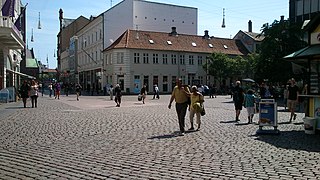
Lille Torv is a cobbled public square located in the Indre By neighborhood in Aarhus, Denmark. It is situated between the squares of Store Torv and Immervad in the historic Latin Quarter neighborhood and it is one of the oldest public squares in Aarhus. The streets of Vestergade, Guldsmedgade, Immervad and Badstuegade radiates from Lille Torv. It is today a venue for public events and gatherings in the city. The square is home to some notable buildings such as the storied Meulengracht's House and the listed Business- and Agricultural Bank of Jutland.

Immervad, previously Emmervad, is a pedestrian street in Aarhus, Denmark which runs north to south from Lille Torv to Åboulevarden and Frederiksgade. The alley Sankt Clemens Stræde leads to Immervad from the east. The street is situated in the historic Latin Quarter neighborhood and has existed as a road or street since the Viking Age when it was used as the eastern ford to cross the Aarhus River. Immervad is fairly short at just 110 meters long but it is one of the streets with the most foot traffic in Aarhus. At the southern section of the street is the bridge of Frederiksbroen, the first bridge built to cross the river in the city.

Frederiksgade is a street in the Indre By district in Aarhus, Denmark which runs north to south from Åboulevarden to Frederiks Allé. Frederiksgade is a major thoroughfare for pedestrians and cyclists and it connects Immervad to ARoS Aarhus Art Museum and the City Hall and Concert Hall parks. The street is fairly narrow and the architecture is primarily late 19th century to early 20th century.
